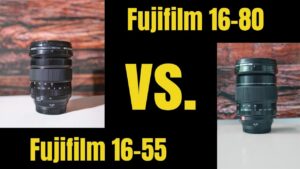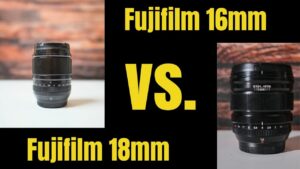Quick Facts about the Fujifilm XF 50-140mm f/2.8 R LM OIS WR Lens
- Weight: 2.19 lb/995 Grams
- Weather Sealed: Yes
- Filter Size: 72mm
- Angle of View: 31.7 to 11.6 Degrees
- Focusing Distance: 3.28’/1m
- Max Aperture: F2.8
- Minimum Aperture: F22
- Image Stabilization: Yes
- Mount System: Fuji X
- Price: $1,599
- Zoom: Internal
Who is the Fujifilm 50-140 F2.8 for?
This 50-140 F2.8’s (Full-Frame Equivalent is 76mm-213mm) focal length is a staple amongst event photographers. It’s low-light functionality (f2.8), variable telephoto length, and superb image sharpness rightfully place this lens amongst Fuji’s best “red-badge” lenses. (Similar to Canon’s “L” or Sony’s “G-Master” lens line-up.)
However, this lens is not without compromise. The 50-140’s significant weight place it in a different class compared to the other APS-C peers. Plus, a full-frame camera also offers a shallower depth of field at f2.8.
Those using this lens for travel will be disappointed and happy. (A weird conundrum, yes.) The 2.8 aperture will allow Shutter Speed and ISO changes in variable lighting such as cities. However, for the occasional wildlife shooter, 140mm feels too short. But at the same time, the 50-140 is one of the few regular telephoto zoom lenses by Fujifilm that is weather-sealed.
What other Fujifilm lenses cover the 50-140 (APS-C)/76-213 (FF) equivalent?

There are numerous other Fuji X lenses that cover the focal length of 50-140 (some not mentioned here). However, the 50-140’s true competitors are lenses that span this length AND designed for similar styles of photography. So, here are a few lenses that have the same focal length as this one.
- Fujifilm XF 55-200mm F3.5-4.8
- Fujifilm XF 70-300mm F4-5.6
- Fujifilm XC 50-230mm F4.5-6.7
- Fujifilm XF 56mm F1.2
- Fujifilm XF 90mm F2
Additional telephoto zooms could come later. Recently, there has been an interest in some third-party (Tamron especially) zooms for the Fuji X Mount.
Fujifilm 50-140 F2.8 Sharpness
As a zoom lens, we can expect variable sharpness throughout both the aperture AND focal length.
However, here is what I discovered for this lens in my “official brick wall test.”
#1 Starting at around F4.0, sharpness remains excellent throughout the entire zoom range. Kudos to Fujifilm for that.
#2 The 50-140 appeared weaker at the short-end rather than the longer end.
#3 The lens performs worst at F2.8…as expected.
For the following example photos, I concentrated on the top-left portion of the photo with a crop factor of 80%. So, this is an extreme crop.
Fujifilm 50-140 at around 50mm



Fujifilm 50-140 at around 70mm



Fujifilm 50-140 at around 90mm



Fujifilm 50-140 f2.8 around 120mm


Fujifilm 50-140 @140mm @f2.8

I was happy with the sharpness of the Fujifilm 50-140 at all focal lengths and apertures. Granted, I never zoom past 100% in any of my photos. However, the complex optical design is superb.
Portrait Bokeh (Out of focus rendering)
All around, I was not very impressed with the bokeh for portraiture. (Out-of-focus rendering.)
I don’t quite know how to describe it, but the background almost looks busy.
Let’s look at example #1 where the subject makes up about 30% of the entire frame.

And now example #2 with a subject that is approximately 10% of the frame. (Yes, I masked out their face.)

Person’s face omitted for privacy
In both pictures, I see duplicates. (Which is kind of weird.)
For example, let’s look at example #1, again. The sign on the left-hand side looks unnatural…almost as if I photoshopped a portrait of myself in front of a shaky, long-exposure.
In example #2, the dog gives the illusion of the same phenomenon.
Another note about this lens’s bokeh. I was not impressed with the “2.8” look.
For example… look at the crosswalk sign. It’s easily readable.
Perhaps I am too picky in regards to bokeh from a 50-140 F2.8…. after all a 70-200 F2.8 actually has shallower depth of field on a full-frame camera.
Fujifilm 50-140 Bokeh Balls

Beginning at f2.8, you can see some cat’s eye within the bokeh balls. It almost begins in the left 1/3 of the frame.
Cat’s eye isn’t a deal-breaker for most people, and stopping down does resolve the cat’s eye.
There is also no onion ring effect!


In my tests, I found the Bokeh balls to round-out around 5.6. (F4 is usable & F8 is perfect.) And it is fascinating that you do not see the beginning of the aperture blades, yet.
However, in order to stop down to that F5.6, I will either significantly either decrease my shutter speed or increase my ISO. For the X-T4, I attempt to avoid increasing my ISO past 4000 for all photos unless I am deliberately trying to introduce noise into the photo.
To give you an example of the bokeh balls in real-time, please see the video below. It should provide a clear example of how the bokeh at 2.8 dramatically changes from the corner to the center.
Hand-Held at 2.8
Fujifilm 50-140 Autofocus
For this autofocus test, we will test via two different parts.
#1 Switching between two different subject via tapping on the back LCD screen.
#2 Eye Autofocus
#1: Switching between two different subject via tapping on the back LCD screen.
I was happy with this lens in regards to its ability to quickly switch between subject.
And despite the colors of the mug, I found it to switch with relative ease.It struggled a bit with the blue mug. However, switching to the laptop case was almost immediate.
#2 Eye Autofocus
For staged compositions like the one below, I didn’t have any problems. It locked on with relative ease, and I was able to take the photo.

Eye Auto-Focus Enabled with X-T4
Still Subject
However, in Continuous (Tracking), the Fujifilm XF 50-140 had some problems…
The video below was shot at
- Any Eye
- Tracking Sensitivity +2
- Autofocus Speed +3
It might be alright for some talking head shots.
Macro Results and Focusing Distance
In this hand-held(!) video, you can see how long it takes for the flower to become clear.
Color Accuracy
I was really happy with the colors rendered from this lens.
The colors are accurate. (The photo below DOES have some minimal processing. I brought out the shadows in the top-right, and I had to remove the pink reflection with a mask on the grey .

OIS Test
Handheld at F2.8 around 90mm
As somebody who uses the 16mm f1.4 and 10-24mm, I am use to wobbling on most of the Fuji-X lenses.
However, not with this one! The footage I obtained from this lens is some of the most usable footage I have ever gotten from a Fuji X Camera!
For the video below, I had both the IBIS and OIS turned on.
Side Note: Anything older than the X-T3 (except the X-H1) within this Fujifilm ecosystem does not have IBIS.
Shot at 50mm
Sunstars/Starbursts

All throughout the frame, I was able to achieve about a 14-point starburst image. Now, at F18, the image and lens will suffer heavily from diffraction. (The lens only has a minimum aperture of F22.) However, you can still create some awesome images.

Lens Flaring
(One way to attempt to salvage this is create a mask and pull down the highlights.)

Alright, before we get into the final rating and notes, I wanted to provide a quick list of the pros and cons of this lens.
Pros of the Fujifilm 50-140 F2.8
- The Fujifilm 50-140 is sharp.
You will be pleased with the results starting at 2.8.
- The IBIS/OIS provide great stabilization.
Cons of the Fujifilm 50-140 F2.8
- Center of Gravity and Weight
Weighing only 2.2 pounds, the lens feels heavy as most Fuji X cameras do not have a significant grip. If you are using a tripod, you will be able to attach the lens to the tripod via the tripod collar. (And the tripod collar does rotate!)
- Bokeh
This might be a “me” thing, but I wasn’t impressed.
- Price
Since being released, the price has not changed from the $1,600 asking point. (Except for certain rebates.) Newer lenses within the same price-point have better optics.
On the bright side, the filter size (72mm) saves you about $10 compared to an 82mm.
My Final Notes
I might be expecting too much from this lens. However, for a premium price, I expect outstanding performance.
If I was purchasing this lens today, I would instead focus on a telephoto zoom (70-300) and a prime within the same category for low-light work. The key differentiator between that prime lens and this 50-140 is the OIS, but with the money saved, I could still purchase a well-built gimbal.
At the end of the day, each camera lens is limited in its output by the photographer. (And I am probably not the best person to test this lens.) But I was disappointed in the price/performance ratio.
My Rating
Price: 3/5
Photography isn’t a cheap hobby, and I think the price is excessive. I could purchase the 70-300 AND a prime lens for the cost of this.
Reliability: 4/5
Paired with the X-T4 or X-T3, it is reliable and the autofocus is good (enough) for most occasions for photography. But for video, no. Plus, I don’t foresee any issues when it comes to build quality. This will deserve a re-test with the X-H2s.
Spoiler alert: It holds up, making this the best XF telephoto lens for videography.
Functionality: 4/5
When it comes to the 70-200 FF equivalent, this focal length is desirable and has utility. However, the points are deducted as the center of gravity prevents this lens from being held comfortably on most Fujifilm cameras.
Style: 4/5
Metal and well-built, the Fuji 50-140 is nice. HOWEVER, the metal body leaves fingerprints. -1 Point for always looking dirty.
Total:15/20 or 75%

Fujifilm 16-55 vs 16-80mm F4
The Fujifilm 16-80mm F4 and 16-55mm F2.8 are some of the most expensive “normal” zoom lenses that Fuji makes. Is the 16-80 so bad? And is the 16-55 better?

Fujifilm 18mm vs 16mm F1.4
Two of the best performing wide-angle, XF lenses made by Fujifilm, the 18mm and 16mm should be a comparison that most people think about. But why don’t they?

Fujifilm 18mm F1.4 Review
If you have ever wanted to test the new, Fujifilm 18mm F1.4, but you haven’t had the money.. And how does the 18mm F1.4 vs 16mm F1.4 compare?

Fujifilm 8mm F3.5 Review
The newest, wide-angle lens for Fujifilm, it retails for $799. But is the Fujifilm 8mm F3.5 worth the cost? And how does it compare against the 8-16mm F2.8?

Fujifilm 16-55mm F2.8 Review
The 16-55mm will soon be 10(!) years old. Maybe that’s the reason it’s better to purchase lenses rather than bodies

Fujifilm 50mm F2 Review
Quick Facts about the Fujifilm 50mm F2 Weight: 7.05oz/200 Grams Weather Sealed: Yes Filter Size: 46mm Angle of View: 31.7 Degrees Focusing Distance: 1.28 feet/39
